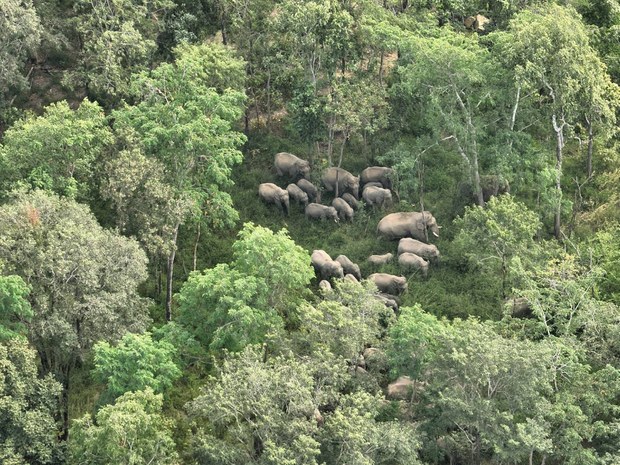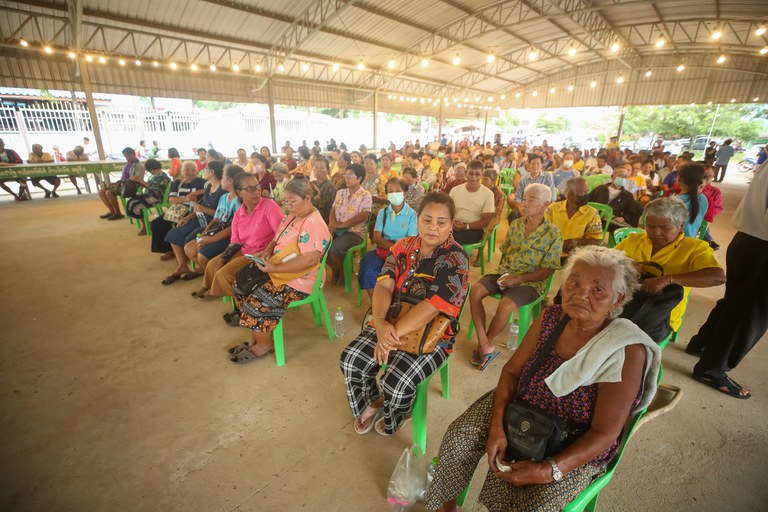Controversy erupts over proposed Thai national park boundary adjustment
2024.07.09
Bangkok
 A herd of elephants is seen foraging in Thap Lan National Park, Dec. 24, 2023.
A herd of elephants is seen foraging in Thap Lan National Park, Dec. 24, 2023.
A proposal to open up a vast tract of Thailand’s second-largest national park for agricultural use is fanning a heated public debate, with environmentalists concerned about the impact on endangered species including elephants, tigers and clouded leopards.
A proposed cabinet resolution seeks to convert about 105,000 acres of protected forest land in Thap Lan National Park into agricultural farms, in an attempt to address the overlapping land disputes between the park and residents in surrounding districts.
The controversy highlights the ongoing tension between conservation efforts and local land rights in Thailand, as the government attempts to balance environmental protection with the needs of rural communities.
The issue has galvanized public opinion, with the hashtag “saveThapLan” shared more than 300,000 times on social media platform X. Many users referenced a call of the late Seub Nakhasathien, a Thai conservationist, to conserve the country’s forested lands.
“The proposal could affect natural drainage and cause sudden flooding. Human activities could also disturb wildlife beyond controllable levels in an area that’s hoped to be a tiger population recovery zone,” environmental group Seub Nakhasathien Foundation said in a statement on Monday.
A crucial global biodiversity hotspot, the 552,500-acre national park, which was established in December 1981, is home to some of the world’s threatened and endangered species such as tigers, elephants, clouded leopards and hornbills.
Spanning the eastern province of Prachin Buri and the northeastern province of Nakhon Ratchasima, the park is part of Dong Phayayen-Khao Yai Forest Complex, a UNESCO World Heritage site.
National Park Office Director Chaiwat Limlikhitaksorn said he was concerned about losing a huge tract of the park’s forest land under the proposed project.
“I was part of the Tiger Corps unit that prosecuted over 400 cases involving land trading and resort building within Thap Lan National Park. We’ve been working to protect forest resources and reduce encroachment. But now, government agencies are trying to expedite boundary demarcation,” Chaiwat said in a July 3 Facebook post.
2000 survey
Under the previous government of former Prime Minister Prayuth Chan-o-cha, the cabinet in March 2023 approved the proposal from the National Land Policy Committee to adjust state land boundaries using a 2000 survey of the park.
Thai Prime Minister Srettha Thavisin, who assumed office in August 2023, said his administration was following through on a resolution made by the previous government.
“The National Land Policy Committee must verify the facts, and the Ministry of Natural Resources and Environment must comply with relevant laws,” Srettha said.
“The crucial thing is to listen to public opinion before any move. There are several processes that must follow legal procedures before being presented to the cabinet,” he said.
Patcharawat Wongsuwan, deputy prime minister and minister of Natural Resources and Environment, said at least 19,770 acres of the proposed land reform project belong to residents of districts surrounding the park.
“We will take good care of the villagers. … The National Park Committee will consider how much land should be returned. We … are ready to listen to nationwide public opinion,” he said.

Some neighbors of the park support the proposal to open land for agricultural use.
Kitchaphat Jaynok, 42, a resident from Wang Nam Khiao district in Nakhon Ratchasima province, argued that the park’s boundaries encroach on long-established communities.
“Villagers were here first, with evidence of village establishment dating back to the 1950s, but the park was declared. We want to call for justice for villagers in over 90 villages across five districts, whose [lands] have been overlapped by the park declaration. Although society may view local villagers as encroachers, 90% of us were here first,” Kitchaphat stated.
Pinkaew Laungaramsri, a sociology and anthropology professor at Chiang Mai University’s Faculty of Social Sciences, criticized the establishment of national parks without consulting existing local communities.
“What some conservation groups intentionally don’t mention is that many national parks were established without surveying and excluding the villagers’ farmlands that existed before the forest areas were declared. They were only interested in increasing forest areas without considering whose lands they were taking. This has become a source of conflict,” she said.
“In reality, it’s the villagers’ lands that have been sacrificed for forests for many decades,” Pinkaew said.
The results of the public hearings, which began on June 28 and run through Friday, are to be forwarded to a national committee overseeing the national park.







